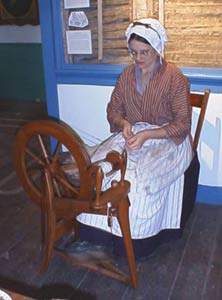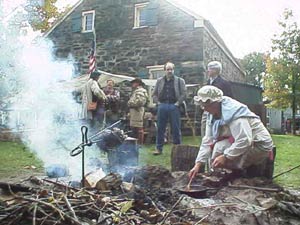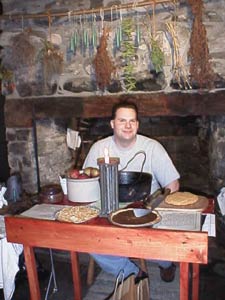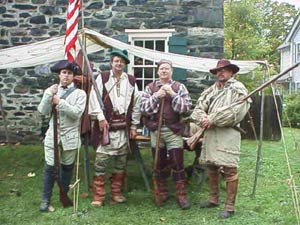Cooking In The Late 18th Century
We are cooking foods that would have been prepared with materials that would have been available to the settlers here on the frontier in the last quarter of the 18th century. We are, for the most part, using methods that would have been used in those times with reproduction kitchenware, some of which you can still find in kitchens across America today.
At the Fort Decker Museum of history we cook foods that would have been prepared with materials that would have been available to the settlers here on the frontier in the last quarter of the eighteenth century. We are, for the most part, using methods that would have been used in those times with reproduction kitchenware, some of which you can still find in kitchens across America today. Foods in those days were generally much less sweet by today's standards as sugar was harder to come by. Recipes, or "receipts," as they were known, tended to be simpler but also harder to cook because there were no microwave ovens in those days or freeze-dried dinners that you could pick up in a supermarket. Everything was prepared from scratch withitems grown on the farm, found nearby, or purchased or traded for locally.
Below are some photographs from the our eighteenth century cooking demonstrations. Our schedule can be found on our calendar page.
Admission is by donation.
Meats were cooked for a much shorter time. For example, today you might roast a whole chicken for 3 to 4 hours. In those days it would have been cooked for 45 minutes. Meat was often rare when served. Fruits and meats were dried and not laced with preservatives as our food is today although it was heavily salted. Food was generally richer, more fatty, because of lard that was used to cook it.
By undertaking this kind of cooking one gains a healthy respect for women of the era and how difficult every day life was. Much of the day was spent just surviving until the next day and preparing stores for the future. The idea of leisure, as we know it, was totally alien to the generations of those that lived on the frontier in the 18th century.
Apple pie
Fat meat and sauerkraut
Potatoes baked in ashes
Cold turkey, fried hominy, toast and cider
Three small Indian hoe (corn) cakes and as many dishes of tea
Milk, bread and pie
Beer thickened with wheat flour, egg, cider
Pancakes of buckwheat
Slices of bread roasted, soaked in milk and butter and called toast
Lunch or Dinner - Served in mid afternoon and being the main meal for the day
Sausage and dried pumpkins
Dumplings
Pig's feet and head and turnips
Beans and butter
Meat and dried pumpkins
Meat and turnips
Salad
Green beans or pumpkins
Wild pigeons
Supper - Usually eaten in the evening
Pumpkins
Dumplings
Salad
Apple pie (evening meal for children)
Milk and mush (or if milk was not available, sweetened water, molasses, bear's oil, or the gravy of fried meat)
Whole pot of chocolate
Glass of punch, draught of beer, two dishes of tea
A Study of Eighteenth Century Foods
by Kay Moss and Kathryn Hoffman
There were a handful of cookbooks available to women during this period as most recipes were simply passed down from mother to daughter. The earliest cookbooks were English and the first used in America was The Compleate Housewife by Eliza Smith and published in London in 1729. Another popular cookbook was the Art of Cookery by Hannah Glass, also English and published in 1747. The Frugal Housewife by Susannah Carter was published in 1777 and 1792 and widely used in America.
The first American cookbook was American Cookery and written by Amelia Simmons of Hartford, Connecticut. It was published in 1796 and was the first cookbook to describe American dishes not common in England, including the use of Indian corn, turkeys, beans, sweet potatoes, chocolate and tomatoes.
Most of the recipes or "receipts" as they were then known, we are using are as close as possible to what was used in the 18th century. In some cases we simply cannot reproduce some of the ingredients that were common then. For example, we cannot make beer here at the society so we must use store-bought yeast. Apples are another ingredient that are very different today from those of the 18th and early 19th centuries. At one time early in the 19th century there were 14,000 varieties of apples available to cooks. Many were limited to specific geographic regions. Today, if you go to the supermarket there are six or seven varieties available.
If we used tallow candles to light the interior of the building there would be an odor that would damage some of our artifacts and probably give you cause to leave. Also, if we butchered a hog on the grounds today as was done every November for almost two hundred and fifty years on this property our neighbors would almost certainly raise a fuss.
Boil water, a quart, three pints, or two quarts, according to the size of your family; sift your meal, stir five or six spoonfuls of it thoroughly into a bowl of water; when the water in the kettle boils, pour into it the contents of the bowl; stir it well, and let it boil up thick; put in salt to suit your own taste, then stand over the kettle, and sprinkle in meal, handful after handful, stirring it very thoroughly all the time, and letting it boil between whiles.
When it is so thick that you stir it with great difficulty, it is about right. It takes about half an hour's cooking. Eat it with milk or molasses. Either Indian meal or rye meal may be used. If the system is in a restricted state, nothing can be better than rye hasty pudding and West India molasses. This diet would save many a one the horrors of dyspepsia.
Lydia Child, 1829
Calf's head should be cleansed with great care; particularly the lights. The head, the heart, and the lights should boil full two hours; the liver should be boiled only one hour. It is better the wind-pipe on, for if it hangs out of the pot while the head is cooking, all the froth will escape through it. The brains, after being thoroughly washed, should be put in a little bag; with one pounded cracker, or as much crumbled bread, seasoned with sifted sage, and tied up and boiled one hour.
After the brains are boiled, they should be well broken up with a knife, and peppered, salted and buttered. They should be put upon the table in a bowl by themselves. Boiling water, thickened with flour and water, with butter melted in it, is the proper sauce; some people love vinegar and pepper mixed with the melted butter; but all are not fond of it; and it is easy for each one to add it for themselves.
Lydia Child, 1829
Apples are peeled, cored, and quartered and then spread upon a platform of boards in the yard. They are soon covered with all the bees, wasps and sucking flies of the neighborhood. This accelerates the operation of drying. Those who have but a small quantity, thread them and hang them in front of their house.
In the same manner we dry peaches and plums without peeling them. To prevent the dried apples from getting wormy, one should not dry your apples until the flies have disappeared and after the weather becomes cold.
A Study of Eighteenth Century Foods
Kay Moss and Kathryn Hoffman
Ordinary Bread (1 loaf)
Stir 1/2 teaspoon salt into 3 cups unbleached flour. Add about 1/2 cup barm diluted to 1 cup blood-warm water (or 1/4 ounce yeast in 1 cup blood-warm water). Mix well, shape into a ball (add more flour if too damp). Cover and leave to rise until doubled (about 2 hours). Knock the dough down and knead thoroughly. Form dough into ball and allow to rise again until doubled (3/4 hour). Bake about 40 minutes in hot oven.
A Study of Eighteenth Century Foods
by Kay Moss and Kathryn Hoffman
Up until the final quarter of the 18th century the only leavening in use for baked goods was yeast or eggs. Yeast was gotten mainly from barm, the froth which forms on ale and beer in the fermentation process, or from saved dough. In either case, this presents a problem in recreating early American bread unless one brews beer as well as baking bread.
Take a parcel of onions chopped very fine and put them into a quarter of a pound of fresh butter boiling hot when they are quite soft; add pease (sic), parsley spinnach (sic), cellery (sic), carrots, kidney beans all but the pease (sic) chopped very fine. Stir them well in the butter and onions until they begin to dry then have a tea kettle of boiling water and put about a pint at a time over your herbs till it is as much as you want. Serve it with bread in the bottom of your dish. - Suit your taste with pepper and Salt - green peppers if in season are good chopped with other vegetables. The vegetables of every season and as many as you can collect will make your soup the better.
The Backcountry Housewife:
A Study of Eighteenth Century Foods
by Kay Moss and Kathryn Hoffman
Calf's Foot Jelly
Boil four feet in a gallon of water, till it is reduced to a quart. Strain it, and let it stand, till it is quite cool. Skim off the fat, and add to the jelly one pint of wine, half a pound of sugar, the whites of six eggs, and the juice of four large lemons; boil all these materials together eight or ten minutes. Then strain into the glasses, or jars, in which you intend to keep it. Some lay a few bits of the lemon-peel at the bottom, and let it be strained upon them.
Lydia Child, 1829
Scald one pint of milk and put to three pints of Indian meal and half pint of flour; bake before the fire. Or scald with milk two-thirds of the Indian meal, or wet two thirds with boiling water, add salt, molasses and shortening, work up with cold water pretty stiff, and bake as above.
Amelia Simmons, 1796
The Backcountry Housewife:
A Study of Eighteenth Century Foods
by Kay Moss and Kathryn Hoffman
1 1/2 cups pumpkin, 3/4 cup brown sugar, firmly packed, 1/2 teaspoon fresh ginger root, grated,1 teaspoon freshly grated nutmeg, 1/2 teaspoon salt,1 cup heavy cream, 3/4 cup milk,1/4 cup dark rum or brandy 3 eggs, lightly beaten, pecans & whipped cream,10 inch pie shell, unbaked.
Mix all ingredients together and put in the prepared pastry shell. Bake at 425 degrees for 10 minutes. Reduce heat to 350 degrees and bake for 40 minutes more, or until a knife inserted in center comes out clean. Garnish with pecans and whipped cream flavored with rum or brandy.
Montclair Historical Society, Montclair, NJ, 1982
Take an Eel washed clean and cut into pieces, add to it water, Butter, Ginger, Onion, a little Salt. Let it stew together until it is done enough, then add chopped Parsley and Lovage to the pot, continue to cook for a little while and dish him up.
Dutch Foodways in the Old World and New World
Peter Rose
1 cup flour, 1 cup cornmeal, 1 cup confectioner's sugar, 1/2 teaspoon dried ground ginger, 1/2 teaspoon cinnamon, 1 cup mashed pumpkin, 2 eggs, lightly beaten with a fork, 2 1/2 - 3 cups milk or more for thinner pancakes, butter for frying.
Combine dry ingredients in a large mixing bowl. Combine pumpkin and eggs. Beat into dry ingredients. Add milk slowly to make a smooth pancake batter. Heat some batter in a frying pan and pour some batter in. Swirl the batter around to make an evenly thick pancake. Cook on both sides until nicely browned. Serve hot, heavily dusted with confectioner's sugar.
Peter Kalm's Travel Accounts, 1749
1 cup sugar, 2 eggs, 1/4 cup of flour, 1 1/2 teaspoons of baking soda, 2 teaspoons cream of tarter, 1/2 teaspoon salt, 1 cup of apples, peeled, cored and chopped, 1 cup of pecans, chopped, 1 teaspoon lemon juice, 1 teaspoon of vanilla extract
Beat the sugar into the eggs until the mixture is thick. Beat in the flour sifted together with the baking soda, cream of tarter, and salt. Stir in the apples, pecans, lemon juice and vanilla extract. Pour the batter into a well buttered 8" x 10" baking dish and bake in a pre-heated moderate oven (325 degrees) for 45 minutes or until browned. The torte will have a firm, crunchy top layer and a softer layer beneath. Serve with heavy whipped cream and a sprinkling of nuts. Serves 6.
Montclair Historical Society
From the late 18th and early 19th centuries
In reading the literature of the period there is advice as relevant today as it was then. There are also quaint practices that have vanished from our culture like beating your rugs outdoors, saving cooking grease for soap or dying your hair with a black-lead comb. Here are some of the missives from Lydia Child who wrote the American Frugal Housewife one of the most popular cookbooks of its time.
The true economy of housekeeping is simply the art of gathering up all fragments, so that nothing be lost. I mean fragments of time, as well as materials.
Nothing should be thrown away so long as it possible to make use of it, however trifling that use may be.
Whatever the size of the family, every member should be employed, either in earning or saving money. I have attempted to teach how money can be saved, not how it can be enjoyed.
Look frequently to the pails, to see that nothing is thrown to the pigs which should have been in the grease-pot. Look to the grease-pot, and see that nothing is there which might have served to nourish your own family, or a poorer one.
In this country we are apt to let children romp away their existence, till they get to be thirteen or fourteen. That is not well.
Cut the ends of your hair in the increase of the moon, and it will grow thick and prevent its falling off: on the contrary, cut it in the decline of the moon, and it will all come off of your head; but if there should be worms at the roots of your hair, that eat it, take three spoonfuls of honey, and a good handful of vine sprigs which twist like wire, beat them well in a marble mortar, strain their juice into the honey, and by anointing the bald place therewith, the hair will grow thick.
Get the berries of an elder tree, boil them in wine, and washing the head with it, it will turn the hair black. Combing the hair with a black-lead comb will make the hair black, but then it comes off on linen prodigiously.
Ink made with the infusion or decoction of wormwood prevents writings from being eaten by rats and mice.
Rubbing a child all over takes off souers (sic), and makes blood circulate. The breast should be rubbed with the hand; one, one way, and the other, the other way, night and morning at least.
A nurse ought to keep a child as little in her arms as possible, lest the legs should be cramped, and the toes turned inwards. Let her always keep the child's legs loose. The oftener its posture is changed the better.
The child should begin to walk upon a carpet or blanket from three months old, the nurse must hold the child by the hips, that the movement in walking may come from that part, and not drag it by the arms.
A principal thing to be always attended to is to give young children constant exercise, and to keep them in proper posture.
Hannah Glass, 1762
Wash the floor with lie (sic) and gall mix'd with it, and rub the bedstead with rue and wormwood, there is nothing better. But of all the reciepts I ever heard of, nothing is so sure a rule as thorough cleanliness, by which with the above, I will answer, you will get rid of them. To Choose a Rabbit or Coney
If a Rabbit be old the claws will be very long and rough, gray hairs intermixed with the wool; but if young the claws and wool smooth. If stale, it would be limber, and the flesh will look blueish, having a kind of slime upon it, but if fresh, it will be stiff and the flesh white and dry. To Choose Pigeons, etc.
The Dove-house pigeons when old are red-legged, when new and fat and limberfooted, and feel full in the vent. When stale their vents are green and flabby.
Hannah Glass, 1762
A large fowl, three quarters of an hour; a middling one, half an hour; very small chickens, twenty minutes. Your fire must be very quick and clear when you lay them down.
Tame Ducks - Observe the same rules
Wild Ducks - Ten minutes at a very quick fire will do them; but if you love them well done, a quarter of an hour.
A Turkey - A middling turkey will take an hour, a very large one, an hour and a quarter; a small one three quarters of an hour. You must paper the breast till near done enough, then take the paper off and froth it up. Your fire must be very good.
Hannah Glass, 1762
Most people spoil garden things by over-boiling them. All things that are green should have a little crispness, for if they are overboiled they neither have any sweetness or beauty.
Let them be scraped very clean, and when they are enough rub them in a clean cloth, then slice them into a plate and pour some melted butter over them. It they are young spring carrots half an hour will boil them; if large, an hour, but old Sandwich carrots will take two hours.
Hannah Glass, 1762
1770-1800
Designed and Created by Peter Osborne
Construction Work by
William Clark & Brian Lewis
The Minisink Valley Historical Society gratefully acknowledges the following people, businesses, institutions and agencies for their assistance in making this exhibit possible: Kelly Millspaugh, Joanna Szakmary, Fort Delaware, Camp Turell, George Fedor, Brian Lewis, Adista Theodore, Dr. Frank Simpson, Peter Osborne, Tom Burrows, Action Towards Independence, Frank Day, William Doyle, Mary & Mead Stapler, David Clark, Sherwin Williams, William Yennie, Miral Haubner, Nancy Conod, Nancy Bello, the late Richard Tarbell, the late Clarence Edwards, the late Cornelius Cuddeback and the late Gertrude Kellam. Funding was provided by William Doyle, David and Joan Bishow, Linda and Robert Schultz, Allison and Charles Gillinder, the Office of the Orange County Historian, Port Jervis Rotary and Kolmar Laboratories.
William Clark and Brian Lewis did yeoman's service in constructing exhibit panels and assisting with building the exhibit. Janis Osborne edited the labels, provided research assistance and did not see her husband for days at a time. The exhibit designer would also like to note the efforts of many area residents who over the years have provided much of the material incorporated into this exhibit and also those who have helped preserve the building and have participated in programs on the site.
Compiled by Peter Osborne
Former Executive Director, Minisink Valley Historical Society
The following resources were used in the creation of this exhibit and will certainly give visitors a more comprehensive view of cooking techniques and values of the late 18th century. Many are still in print and can be obtained from sources on the Internet.
by Hannah Glass, 1762
Colonial Williamsburg Foundation, Williamsburg, Virginia
Publishing Company, 1962
Edited by Caroline Sloat, 2nd Edition, The Globe Pequot Press, Guilford, Connecticut
Eberly Press, East Lansing, Michigan, 1995
Montclair, New Jersey, 1982
Amelia Simmons, 1796, Dover Publications, New York
Favorite Recipes of the All of The Presidents of the United States,
Parents Magazine Press, New York, New York, 1970







